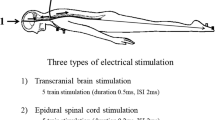Abstract
The diagnostic relevance of recording motor evoked potentials (MEPs) after electrical stimulation of the cervical region, as compared with conventional needle electromyography (EMG), was evaluated in 26 patients with brachial plexus (BP) damage of different aetiology, severity and topography. MEP abnormalities (absence or latency increase) were observed in at least one muscle of all the patients, with a global incidence of 61.5% of the muscles examined. Neurogenic EMG signs were present in all but one patient with an incidence of 62.2% of the muscles examined. Combining the two methods, the global incidence of abnormalities rose to 69.9%. MEP abnormalities were consistent with the clinical topography and severity of BP lesions and were fairly parallel with EMG findings. Recording MEPs after percutaneous electrical stimulation of the cervical region may be regarded as a rapid, non-invasive method for quantitative electrophysiological assessment of BP damage.
Similar content being viewed by others
References
Abbruzzese G, Dall'Agata D, Morena M, Simonetti S, Spadavecchia L, Severi P, Andrioli GC, Favale E (1988) Electrical stimulation of the motor tracts in cervical spondylosis. J Neurol Neurosurg Psychiatry 51:796–802
Aminoff MJ, Olney RK, Parry GJ, Raskin NH (1988) Relative utility of different electrophysiologic techniques in the evaluation of brachial plexopathies. Neuroloy 38:546–550
Britton TC, Mayer BU, Herdman J, Benecke R (1990) Clinical use of the magnetic stimulator in the investigation of peripheral conduction time. Muscle Nerve 13:396–406
Chokroverty S, Picone MA, Chokroverty M (1991) Percutaneous magnetic coil stimulation of human cervical vertebral column: site of stimulation and clinical application. Electroencephalogr Clin Neurophysiol 81:359–365
Epstein CM, Fernandez-Beer E, Weissman J, Matsuura S (1991) Cervical magnetic stimulation: the role of the neural foramen. Neurology 41:677–680
Flaggman PD, Kelly JJ (1980) Brachial plexus neuropathy: an electrophysiologic evaluation. Arch Neurol 37:160–164
Jones SJ (1979) Investigation of brachial plexus traction lesions by peripheral and spinal somatosensory evoked potentials. J Neurol Neurosurg Psychiatry 42:1107–1116
Maccabee PJ, Amassian VE, Eberle LP, Rudell AP, Cracco RQ, Lai KS, Somasundarum M (1991) Measurement of the electric field induced into inhomogeneous volume conductors by magnetic coils: application to human spinal neurogeometry. Electroencephalogr Clin Neurophysiol 81:224–237
Merton PA, Morton HB, Hill DK, Marsden CD (1982) Scope of a technique for electrical stimulation of human brain, spinal cord, and muscle. Lancet II:597–600
Mills KR, Murray NMF (1986) Electrical stimulation over the human vertebral column: which neural elements are excited? Electroencephalogr Clin Neurophysiol 63:582–589
Mills KR, Murray NMF (1986) Proximal slowing and conduction block in acute and chronic demyelinating neuropathy. J Neurol Neurosurg Psychiatry 49:476
Mumenthaler M, Narakas A, Gilliatt RW (1984) Brachial plexus disorders. In: Dyck PJ, Thomas PK, Lambert EH, Bunge R (eds) Peripheral neuropathy, vol 2. Saunders, Philadelphia, pp 1383–1423
Plassman BL, Gandevia SC (1989) High-voltage stimulation over the human spinal cord: sources of latency variation. J Neurol Neurosurg Psychiatry 52:213–217
Schmid UD, Walker G, Hess CW, Schmid J (1990) Magnetic and electrical stimulation of cervical motor roots: technique, site and mechanisms of excitation. J Neurol Neurosurg Psychiatry 53:770–777
Synek VM, Cowan JC (1982) Somatosensory evoked potentials in patients with supraclavicular brachial plexus injuries. Neurology 32:1347–1352
Ugawa Y, Rothwell JC, Day BL, Thompson PD, Marsden CD (1989) Magnetic stimulation over the spinal enlargements. J Neurol Neurosurg Psychiatry 52:1025–1032
Veilleux M, Stevens JC, Campbell JK (1988) Somatosensory evoked potentials: lack of value for diagnosis of thoracic outlet syndrome. Muscle Nerve 11:571–575
Wulff CH, Gillian RW (1979) F waves in patients with hand wasting caused by a cervical rib and band. Muscle Nerve 2:452–457
Yiannikas C, Shahani BT, Young RR (1983) The investigation of traumatic lesions of the brachial plexus by electromyography and short latency somatosensory potentials evoked by stimulation of multiple peripheral nerves. J Neurol Neurosurg Psychiatry 46:1014–1022
Author information
Authors and Affiliations
Rights and permissions
About this article
Cite this article
Abbruzzese, G., Morena, M., Caponnetto, C. et al. Motor evoked potentials following cervical electrical stimulation in brachial plexus lesions. J Neurol 241, 63–67 (1993). https://doi.org/10.1007/BF00869765
Received:
Revised:
Accepted:
Issue Date:
DOI: https://doi.org/10.1007/BF00869765




